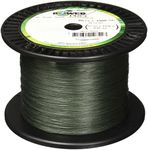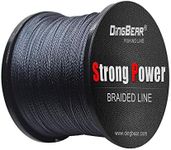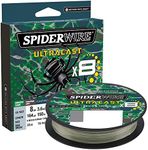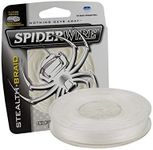Buying Guide for the Best Braided Fishing Lines
Choosing the right braided fishing line can make a big difference in your fishing experience. Braided lines are known for their strength, thin diameter, and low stretch, making them popular for many types of fishing. When picking a braided line, it's important to consider where and how you'll be fishing, as well as the type of fish you're targeting. Understanding the key specifications will help you select a line that matches your needs and maximizes your success on the water.Pound Test (Strength)The pound test refers to the amount of weight the line can handle before breaking. This is important because it determines what size and type of fish you can safely catch without the line snapping. Lighter pound tests (under 15 lbs) are suitable for small fish and finesse fishing, while medium pound tests (15-30 lbs) work well for average-sized freshwater and inshore saltwater fish. Heavy pound tests (over 30 lbs) are best for big game fish or fishing in heavy cover. To pick the right strength, think about the size of fish you expect to catch and the conditions you'll be fishing in.
Line DiameterLine diameter is how thick the fishing line is. Braided lines are thinner than other types for the same strength, which means you can fit more line on your reel and cast farther. Thinner lines are less visible to fish and cut through water and vegetation more easily, but they can be harder to handle and may dig into the spool. Thicker lines are easier to manage and more abrasion-resistant. Choose a diameter that balances casting distance, visibility, and manageability for your fishing style.
Number of Strands (Carrier Count)Braided lines are made by weaving together several strands, often called carriers. Common options are 4, 8, or even 12 strands. Fewer strands (like 4) make the line rougher and more abrasion-resistant, which is good for fishing around rocks or heavy cover. More strands (like 8 or 12) make the line smoother, which helps with longer casts and quieter movement through the guides. Pick a lower strand count for tough environments and a higher count for smooth casting and open water.
ColorBraided lines come in various colors, such as green, yellow, blue, or even multi-color. Color affects visibility above and below water. High-visibility colors help you see the line and detect bites, which is useful for certain techniques. Low-visibility colors blend in with the water, making the line less noticeable to fish. Choose a color based on the water clarity and your need to see the line while fishing.
Abrasion ResistanceAbrasion resistance is how well the line can withstand rubbing against rocks, logs, or other underwater obstacles. This is important if you fish in areas with lots of cover or structure. Lines with higher abrasion resistance last longer and are less likely to break when dragged over rough surfaces. If you fish in open water, this may be less important, but for heavy cover or rocky areas, prioritize abrasion resistance.
StretchBraided lines have very little stretch compared to other types. Low stretch means you feel bites more easily and can set the hook quickly, which is great for techniques that require sensitivity. However, the lack of stretch can make it easier to pull hooks out of fish or break the line if you’re not careful. If you need maximum sensitivity, braided line is a good choice, but be mindful of your hook-setting technique.
















